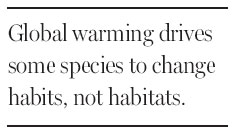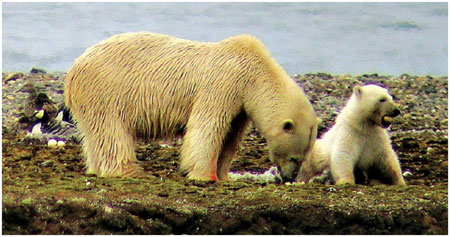Society
In climate change, dire signs of a die-off
Updated: 2011-04-17 07:48
By Carl Zimmer (New York Times)
|
The number of species facing extinction may be underestimated. Deprived of seal, a polar bear raided a goose nest. Jouke Prop |
 |
Over the past 540 million years, Earth has seen five great mass extinctions. In each of those catastrophes, an estimated 75 percent or more of all species disappeared in a few million years or less.
For decades, scientists have warned that humans may be ushering in a sixth mass extinction, and recently a group of scientists at the University of California, Berkeley, tested the hypothesis. They applied new statistical methods to a new generation of fossil databases. As they reported last month in the journal Nature, the current rate of extinctions is far above normal. If endangered species continue to disappear, a sixth extinction will occur, over just the next few centuries or millennia.
The scientists warn that their new study may actually grossly underestimate how many species could disappear. Besides human means like hunting, overfishing and deforestation, many scientists expect that global warming could add even more devastation. "The current rate and magnitude of climate change are faster and more severe than many species have experienced in their evolutionary history," said Anthony Barnosky, the lead author of the study.
But scientists have difficulty linking the fate of any single species to climate. Policy makers would like a better idea of how many species will risk extinction. Scientists, however, are pushing back.
"We need to stand firm about the real complexity of biological systems and not let policy makers push us into simplistic answers," said Camille Parmesan, a biologist at the University of Texas. She and others are calling for conservation measures that don't rely on precision.
Dr. Parmesan has gathered some of the most compelling evidence that global warming is already having an effect.
In 2003, she and Gary Yohe, an economist at Wesleyan University,found that the ranges of more than 1,700 species of plants and animals were moving, on average, 6.1 kilometers per decade toward the poles. Animals and plants were also moving, and also up mountain slopes.
But other researchers have been seeking to attribute changes in individual species to climate change.
In the journal Nature Climate Change, Dr. Parmesan and others argue that trying to attribute specific biological changes to global warming is the wrong way to go. While the global fingerprint of climate change may be clear, the picture can get blurry in individual species.
In Europe, for example, the map butterfly has expanded its range at its northern and southern edges. Global warming probably has something to do with its northern expansion. But the butterflies are also benefiting from the mowing of roadsides, which allows more nettle plants to grow. Because map butterflies feed on nettles, they're able to survive across a broader range of Europe.
But some researchers counter that such studies can be worthwhile cases where global warming's impact on an individual species is clear. "The fact that the task may simply be too challenging in most cases does not mean that it will be impossible or a waste of effort in some particular cases," said Daithi Stone, a climate scientist at the University of Cape Town in South Africa.
Tracking the effects of climate change on species today can help show how nature may respond to it in decades to come. And many scientists think that the future looks grim. As temperatures rise, many species may not be able to shift their ranges to a comfortable environment. Their ranges may shrink, pushing them toward extinction.
Models to predict these future range shifts gained prominence in 2004, when a global team published a study of more than a thousand species. They estimated that 15 percent to 37 percent of all species could become "committed to extinction" by 2050, thanks to climate change.
But in his new book, "Driven to Extinction," Richard Pearson, the director of biodiversity informatics research at the American Museum of Natural History, says he cringed to see the research reduced to simple, stark headlines that said a million species were doomed.
"It's been a very powerful tool, but my concern is that it's very weak on biology," said Georgina Mace of Imperial College London.
Animals may adapt by changing their behavior. Polar bears, for example, are having a harder time hunting seals because of melting sea ice. So some bears are getting more food on land, raiding goose nests for their eggs.
Humans add even more complexity. Cities and farms now block the path for many species that might otherwise be able to spread to more suitable habitats, for example. Scientists in Australia have found that coral reefs are more resilient against global warming if they're protected from overfishing.
Such research will become the basis for decisions about which species to help, and how. Dr. Mace believes some especially vulnerable species may need to be moved to new habitats to survive. But Dr. Pearson argues for setting aside more land. More space will help keep species ranges large even if they shift.
"We need to give nature the opportunity to respond," he said.
The New York Times
E-paper

Han me downs
Traditional 3,000-year-old clothes are making a comeback.
Reaching out
Fast growth fuels rise in super rich
Chinese tourists spend more
Specials

Big spenders
More mainland tourists are expected to spend money on overseas travel this year.

Rise in super rich
Report cites rising property prices, gdp as key drivers of increasing number of chinese millionaires.

Reaching out
Condom makers are stepping up their presence in smaller cities to boost sales

